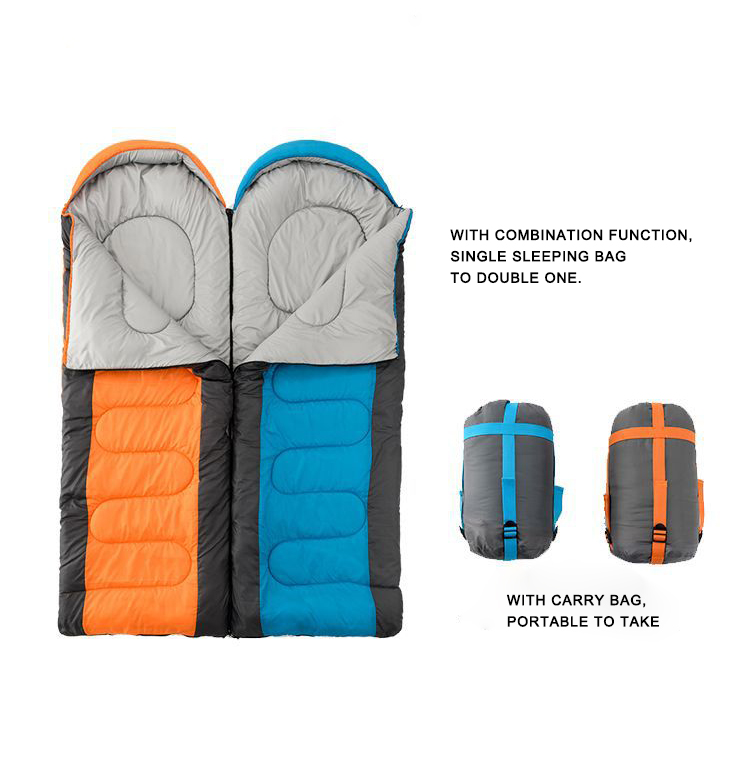
Know the Expected Conditions: Determine the typical weather conditions of your camping or hiking trips. Will you be camping in warm summer nights, cool spring or fall weather, or cold winter conditions? Knowing the expected temperature range will help you narrow down the appropriate temperature rating for your sleeping bag.
Consider Personal Tolerance to Cold: People have different tolerance levels to cold temperatures. If you tend to sleep colder than others, consider choosing a sleeping bag with a lower temperature rating than the expected minimum temperature. Conversely, if you are a warm sleeper or plan to use the bag in relatively mild conditions, you may opt for a higher temperature rating.
Three-Season Versatility: If you engage in camping trips across different seasons, consider a three-season sleeping bag (temperature rating of about 10°F to 32°F). These bags offer versatility and are suitable for spring, summer, and fall camping.
Pay Attention to Comfort Rating: Focus on the "comfort rating" rather than the "lower limit" or "extreme" rating. The comfort rating indicates the lowest temperature at which an average person can sleep comfortably in the bag. It's essential to prioritize comfort to ensure a good night's sleep.
Consider the Insulation Type: Choose between down and synthetic insulation based on your needs. Down sleeping bags generally have a better warmth-to-weight ratio and are ideal for colder temperatures. Synthetic bags, on the other hand, perform better in wet conditions as they retain warmth when damp.
Check Fill Power (For Down Bags): If you opt for a down sleeping bag, consider the fill power. The higher fill power indicates better insulation, meaning the bag can be lighter and more compressible for the same level of warmth.
Bag Shape and Design: Mummy-shaped sleeping bags with a snug fit around the body offer better warmth retention than rectangular bags. Look for features like draft collars, insulated hoods, and full-length zippers for better temperature regulation.
Evaluate Weight and Packability: If you are backpacking or carrying your gear for extended periods, consider the weight and packability of the sleeping bag. Lighter and more compressible bags are advantageous for backpacking trips.
Read Reviews and Seek Recommendations: Look for reviews and recommendations from other outdoor enthusiasts to gain insights into the performance and comfort of different sleeping bag models and temperature ratings.
Test the Sleeping Bag: Whenever possible, try out the sleeping bag in-store or borrow one from a friend to test its comfort and warmth. This hands-on experience can help you gauge if the bag suits your needs.
The big choice here is whether you want a bag that’s insulated with down fill or synthetic fill. Below is a rundown of the benefits of each insulation:
|
Insulation Type |
Key Benefit |
|---|---|
| Synthetic Insulation |
Affordable Continues to insulate when damp Dries fast Non-allergenic |
| Down Insulation |
Lightweight Performs well in cold, dry weather Often has a water-resistant treatment to protect it in damp conditions Compresses small for easy packing Is durable—it retains loft and warmth well over the years |
Understanding Sleeping Bag Temperature Ratings
The two main types of temperature ratings you'll encounter are:
Comfort Rating: This is the lowest temperature at which an average person can sleep comfortably in the sleeping bag. You should use this rating as a guide if you are a cold sleeper or expect colder conditions during your trip.
Lower Limit (or Extreme) Rating: This is the lowest temperature at which an average person can sleep for an extended period without risk of hypothermia. It is not recommended to rely on this rating for comfort, as it represents the survival limit rather than comfort.
Factors Affecting Temperature Ratings:
Insulation Type: Sleeping bags are filled with different insulation materials, such as down or synthetic. Down sleeping bags generally provide a better warmth-to-weight ratio and are known for their excellent insulation. Synthetic bags, while heavier, offer better performance in wet conditions as they retain warmth when damp.
Fill Power (Down Bags): For down sleeping bags, fill power measures the quality of the down insulation. Higher fill power indicates better insulation, allowing the bag to be lighter and more compressible for the same level of warmth.
Bag Shape: The shape of the sleeping bag can impact its warmth. Mummy-shaped bags with a snug fit around the body retain heat more effectively than rectangular bags.
Construction: The way the sleeping bag is constructed can affect its temperature performance. Baffles, seams, and hood design play a role in reducing heat loss and maintaining warmth.
User's Metabolism and Clothing: Individual factors like metabolism and clothing layers can affect your personal comfort within a sleeping bag. Some people may sleep colder or warmer than the average, so consider your personal preferences and needs.
Temperature Rating Categories:
Sleeping bags are often categorized into three types based on their temperature ratings:
Summer Bags (32°F or higher): Suitable for warm summer nights or mild climates.
Three-Season Bags (10°F to 32°F): Ideal for spring, summer, and fall camping, covering a broad range of temperatures.
Winter Bags (10°F or lower): Designed for cold winter camping or extreme cold conditions.
It's important to choose a sleeping bag that matches the expected temperature conditions of your outdoor trips. If you plan to camp in colder conditions, it's generally safer to choose a sleeping bag with a lower temperature rating to ensure comfort and safety.
Keep in mind that other factors, such as the use of a sleeping pad and proper clothing layers, can also impact your overall comfort and warmth inside the sleeping bag. Always read and follow the manufacturer's guidelines and consider individual factors to make an informed decision about the right sleeping bag for your needs.
